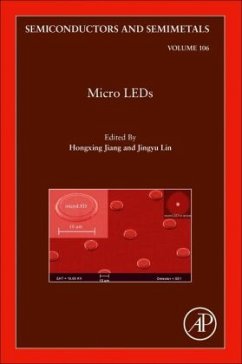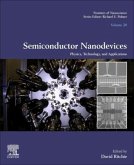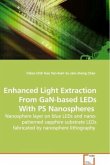Micro LEDs
Herausgegeben:Jiang, Hongxing; Lin, Jingyu
Micro LEDs
Herausgegeben:Jiang, Hongxing; Lin, Jingyu
- Gebundenes Buch
- Merkliste
- Auf die Merkliste
- Bewerten Bewerten
- Teilen
- Produkt teilen
- Produkterinnerung
- Produkterinnerung
MicroLEDs', Volume 106 is currently recognized as the ultimate display technology and one of the fastest-growing technologies in the world as technology giants utilize it on a wide-ranging set of products. This volume combines contributions from MicroLED pioneers and world's leading experts in the field who focus on the MicroLED development, current cutting-edge technologies of pursuing for realizing MicroLED large flat panel displays and televisions, virtual reality and 3D displays, light source for LI-FI data communications, neural interface and optogenetics, and future MicroLED technology trends.…mehr
Andere Kunden interessierten sich auch für
![Semiconductor Nanodevices Semiconductor Nanodevices]() Semiconductor Nanodevices144,99 €
Semiconductor Nanodevices144,99 €![Nanomaterials Synthesis Nanomaterials Synthesis]() Nanomaterials Synthesis142,99 €
Nanomaterials Synthesis142,99 €![Enhanced Light Extraction From GaN-based LEDs With PS Nanospheres Enhanced Light Extraction From GaN-based LEDs With PS Nanospheres]() Chien-Chih KaoEnhanced Light Extraction From GaN-based LEDs With PS Nanospheres32,99 €
Chien-Chih KaoEnhanced Light Extraction From GaN-based LEDs With PS Nanospheres32,99 €![Fundamentals of Heat and Fluid Flow in High Temperature Fuel Cells Fundamentals of Heat and Fluid Flow in High Temperature Fuel Cells]() Majid GhassemiFundamentals of Heat and Fluid Flow in High Temperature Fuel Cells116,99 €
Majid GhassemiFundamentals of Heat and Fluid Flow in High Temperature Fuel Cells116,99 €![Ultraviolet LED Technology for Food Applications Ultraviolet LED Technology for Food Applications]() Ultraviolet LED Technology for Food Applications66,99 €
Ultraviolet LED Technology for Food Applications66,99 €![One-dimensional Nanostructures for PEM Fuel Cell Applications One-dimensional Nanostructures for PEM Fuel Cell Applications]() Shangfeng DuOne-dimensional Nanostructures for PEM Fuel Cell Applications41,99 €
Shangfeng DuOne-dimensional Nanostructures for PEM Fuel Cell Applications41,99 €![Microfluidic Biosensors Microfluidic Biosensors]() Microfluidic Biosensors117,99 €
Microfluidic Biosensors117,99 €-
-
-
MicroLEDs', Volume 106 is currently recognized as the ultimate display technology and one of the fastest-growing technologies in the world as technology giants utilize it on a wide-ranging set of products. This volume combines contributions from MicroLED pioneers and world's leading experts in the field who focus on the MicroLED development, current cutting-edge technologies of pursuing for realizing MicroLED large flat panel displays and televisions, virtual reality and 3D displays, light source for LI-FI data communications, neural interface and optogenetics, and future MicroLED technology trends.
Produktdetails
- Produktdetails
- Semiconductors and Semimetals Volume 106
- Verlag: Academic Press / Elsevier Science & Technology
- Artikelnr. des Verlages: S0080-8784(21)X0002-6
- Englisch
- Abmessung: 22mm x 152mm x 229mm
- Gewicht: 810g
- ISBN-13: 9780128230411
- Artikelnr.: 67578569
- Semiconductors and Semimetals Volume 106
- Verlag: Academic Press / Elsevier Science & Technology
- Artikelnr. des Verlages: S0080-8784(21)X0002-6
- Englisch
- Abmessung: 22mm x 152mm x 229mm
- Gewicht: 810g
- ISBN-13: 9780128230411
- Artikelnr.: 67578569
Dr. Jingyu Lin received her BS in Physics in 1983 from the State University of New York College at Oneonta. She obtained PhD in Physics in 1989 from Syracuse University under the guidance of the late Prof. Arnold Honig (an academic descendant of the late Nobel laureate Prof. Charles Townes). Dr. Lin devotes her research efforts to the development of novel materials and devices for lighting, display, energy conversion, and radiation sensing based on III-nitride wide bandgap semiconductors. She is the inaugural Linda Whitacre Endowed Chair and Horn Distinguished Professor of Electrical & Computer Engineering at Texas Tech University. In 2000, Dr. Lin co-invented the MicroLED; in 2002, she co-invented single-chip high-voltage AC/DC-LEDs for general illumination, and in 2011, she and her colleagues realized the first video-capable MicroLED microdisplay in VGA format, which transitioned MicroLEDs from prototype to reality and inspired worldwide development of MicroLED products. She is
also recognized for pioneering the development in 1997 of the first "frequency-quadrupled? picosecond time-resolved optical spectroscopy system to cover the spectral range of deep UV (to 195 nm). She is the co-founder of III-N Technology, Inc. and AC-LED Lighting, LLC, which facilitated commercialization of high-voltage AC/DC LEDs and MicroLEDs. She has 19 issued patents. More recently, she and her colleagues have achieved boron nitride (BN) neutron detectors with a record high efficiency among solid-state detectors, which has the potential to revolutionize neutron detector technologies. She relocated to Texas Tech in 2008 from Kansas State University where she was a Professor of Physics. Prof. Lin is an elected Fellow of the American Association for the Advancement of Science (AAAS), the American Physical Society (APS), the Optical Society of America (OSA), the SPIE - the international society for optics and photonics, and the National Academy of Inventors (NAI).
also recognized for pioneering the development in 1997 of the first "frequency-quadrupled? picosecond time-resolved optical spectroscopy system to cover the spectral range of deep UV (to 195 nm). She is the co-founder of III-N Technology, Inc. and AC-LED Lighting, LLC, which facilitated commercialization of high-voltage AC/DC LEDs and MicroLEDs. She has 19 issued patents. More recently, she and her colleagues have achieved boron nitride (BN) neutron detectors with a record high efficiency among solid-state detectors, which has the potential to revolutionize neutron detector technologies. She relocated to Texas Tech in 2008 from Kansas State University where she was a Professor of Physics. Prof. Lin is an elected Fellow of the American Association for the Advancement of Science (AAAS), the American Physical Society (APS), the Optical Society of America (OSA), the SPIE - the international society for optics and photonics, and the National Academy of Inventors (NAI).
1. Development of nitride microLEDs and displays Hongxing Jiang and Jingyu Lin 2. Micro-LEDs for biomedical applications Jonathan McKendry, Erdan Gu, Niall McAlinden, Nicolas Laurand, Keith Mathieson and Martin D. Dawson 3. High external quantum efficiency III-nitride micro-light-emitting diodes Matthew S. Wong, Shuji Nakamura and Steven P. DenBaars 4. GaN-on-silicon microleds for neural interfaces Kanghwan Kim, Fan Wu, Kensall D. Wise and Euisik Yoon 5. Quantum-dot-based full-color micro-LED displays Tingzhu Wu, Yu-Ming Huang, Konthoujam James Singh, Zhong Chen and Hao-Chung Kuo 6. Damage-free neutral beam etching for GaN micro-LEDs processing Xuelun Wang and Seiji Samukawa 7. From nanoLEDs to the realization of RGB-emitting microLEDs Zhaoxia Bi, Zhen Chen, Fariba Danesh and Lars Samuelson 8. Mass transfer for Micro-LED display: Transfer printing techniques Changhong Linghu, Shun Zhang, Chengjun Wang, Hongyu Luo and Jizhou Song 9. Micro-LED based optical wireless communications systems P. Tian, J.J.D. McKendry, J. Herrnsdorf, S. Zhu, E. Gu, N. Laurand and M.D. Dawson 10. Angular color shift and power consumption of RGB micro-LED displays Fangwang Gou, En-Lin Hsiang and Shin-Tson Wu 11. Monolithic integration of AlGaInP red and InGaN blue/green LEDs Dong-Seon Lee and Sang Hyeon Kim
1. Development of nitride microLEDs and displays Hongxing Jiang and Jingyu Lin 2. Micro-LEDs for biomedical applications Jonathan McKendry, Erdan Gu, Niall McAlinden, Nicolas Laurand, Keith Mathieson and Martin D. Dawson 3. High external quantum efficiency III-nitride micro-light-emitting diodes Matthew S. Wong, Shuji Nakamura and Steven P. DenBaars 4. GaN-on-silicon microleds for neural interfaces Kanghwan Kim, Fan Wu, Kensall D. Wise and Euisik Yoon 5. Quantum-dot-based full-color micro-LED displays Tingzhu Wu, Yu-Ming Huang, Konthoujam James Singh, Zhong Chen and Hao-Chung Kuo 6. Damage-free neutral beam etching for GaN micro-LEDs processing Xuelun Wang and Seiji Samukawa 7. From nanoLEDs to the realization of RGB-emitting microLEDs Zhaoxia Bi, Zhen Chen, Fariba Danesh and Lars Samuelson 8. Mass transfer for Micro-LED display: Transfer printing techniques Changhong Linghu, Shun Zhang, Chengjun Wang, Hongyu Luo and Jizhou Song 9. Micro-LED based optical wireless communications systems P. Tian, J.J.D. McKendry, J. Herrnsdorf, S. Zhu, E. Gu, N. Laurand and M.D. Dawson 10. Angular color shift and power consumption of RGB micro-LED displays Fangwang Gou, En-Lin Hsiang and Shin-Tson Wu 11. Monolithic integration of AlGaInP red and InGaN blue/green LEDs Dong-Seon Lee and Sang Hyeon Kim







